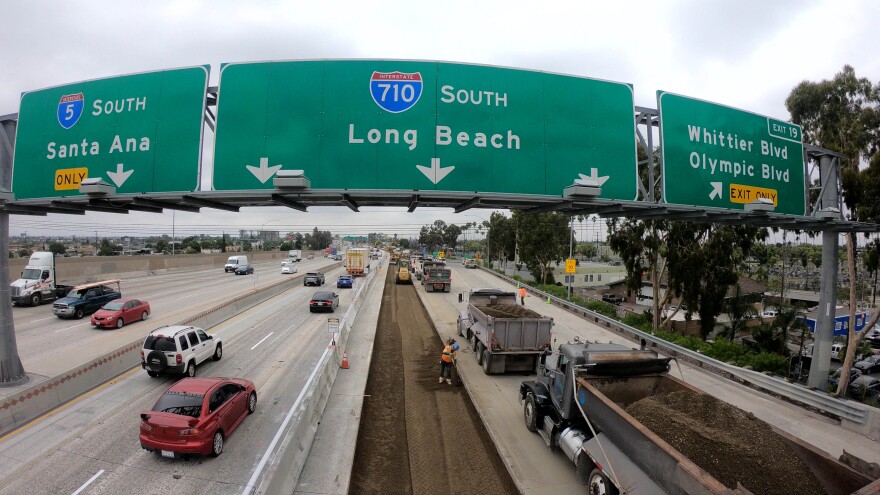Truth matters. Community matters. Your support makes both possible. LAist is one of the few places where news remains independent and free from political and corporate influence. Stand up for truth and for LAist. Make your tax-deductible donation now.
LA Metro Has Scrapped Its 710 Freeway Widening Plan. Here’s What’s Next For The ‘Diesel Death Zone’

After decades of studying and planning, Los Angeles County’s transit agency has officially decided not to add traffic lanes to one of the region's most congested, most polluting freeways.
The L.A. County Metropolitan Transportation Authority’s board voted unanimously Thursday to scrap its $6 billion freeway widening plan for the southern section of the 710 Freeway.
The decision was celebrated by community activists and environmental groups, who have long opposed the project.
Today the Metro Board approved a "No Build" for the I-710 South Corridor Project Final Environmental Document. This is the result of 2 decades of community members standing up and fighting for health and improved air quality. pic.twitter.com/QgG0GcGouA
— EYCEJ (@EYCEJ) May 26, 2022

The 19-mile portion of the busy interstate starts in East Los Angeles and follows the L.A. River south to Long Beach, passing a number of smaller L.A. County cities along the way. It’s also a key corridor for imports to the U.S., due to its connections to the ports of L.A. and Long Beach. Metro officials stated that “40% of all waterborne or containerized imports into the United States” come through our two local ports.
That means a lot of big, diesel burning trucks crawl up and down the 710, spewing harmful particulate pollution that gets breathed in by roughly 1.2 million people who live along the corridor — an area that’s been dubbed the “diesel death zone.”
The vast majority of the people living along the 710 — 83% — identify as Black or Hispanic, according to Metro.
“These residents face some of the worst air quality anywhere in the country, as the corridor accounts for 20% of all particulate emissions in Southern California,” officials wrote in a motion, noting just how hazardous freeway traffic is for Southeast Los Angeles (SELA) communities.
"These high levels of pollutants have been linked to health challenges including decreased lung function, asthma, increased lung and heart disease symptoms, and chronic bronchitis in communities along the corridor, which also face long-standing disparities in health and access to healthcare."
Metro leaders’ decision comes after federal and state officials withdrew their support from the project last year. In March 2021, the U.S. Environmental Protection Agency outlined “significant issues with this proposal that are in conflict with the Clean Air Act.”
Widening the freeway would have also forced out many residents living next to the existing route.
That “displacement of people and businesses in disadvantaged, minority communities through widening the I-710 South freeway… runs contrary to current Board, state, and federal sentiment,” Metro officials wrote in a presentation.
Reimagining The Corridor
The board also took action to redirect $750 million in Measure R and Measure M funds earmarked for the freeway project into community-led improvements along the corridor.
The motion, introduced by board member and county Supervisor Janice Hahn, directs Metro’s CEO to develop a plan in partnership with local cities and community groups and aim to complete a slate of “major investments” by 2028.
“Our 710 communities are really looking for some quality-of-life improvements as soon as possible,” Hahn said during Thursday’s meeting. “This motion will give us the opportunity to reimagine the 710 freeway project [and] makes clear that we are no longer going to widen the freeway — we're no longer going to wipe out homes and neighborhoods for a freeway project.”
Some potential investments she mentioned at Thursday’s meeting:
- Simplifying transit connections
- Improving local streets for pedestrians, cyclists and drivers
- Better air filtration in nearby schools
- Building more freeway sound walls
- Enhancing access to the L.A. River
- Investing in a zero-emissions truck program
Widening Woes
The initial goal of the project was “to improve traffic flow and decrease traffic congestion.” But that idea, that making freeways wider will solve our traffic problems, has long been disproven by researchers.
Remember when we widened the 405 Freeway in the early 2010s and made driving through the Sepulveda Pass a breeze? Of course you don’t, because that five-year, $1 billion dollar project actually increased congestion.

L.A. Metro knows this, but still some of its planners work from the stance that expanding local freeways — and often displacing residents in the process — is a necessary step to reduce congestion. Others within the agency view widening as a useless effort that only makes traffic worse.
Back in 2019, Shahrzad Amiri, who runs Metro’s Congestion Reduction Program, told me:
“Nobody has been able to build their way out of freeway congestion by adding lanes and we are not in a position to do so in L.A. County, because we’re fully built out.”
So what’s the solution? Progressive voices at Metro say it’s about managing the congestion we have, and the agency has been exploring ways to do that.
The most promising plan so far: making people pay to drive on high-demand roadways during peak travel times, also known as congestion pricing. A version of this exists already in the form of express lanes (which Metro is also looking to expand).
The agency has launched a study to see how congestion pricing might work in four specific high-traffic areas. Metro officials aim to present a pilot program to the board next year and begin the congestion experiment in 2026.







